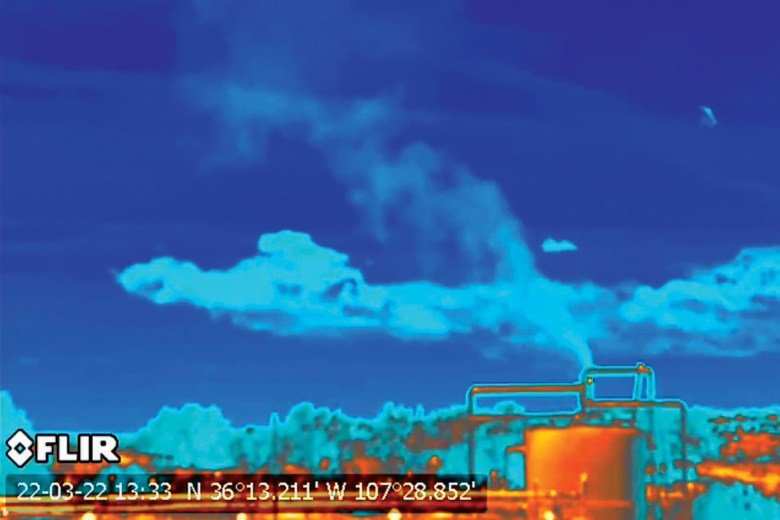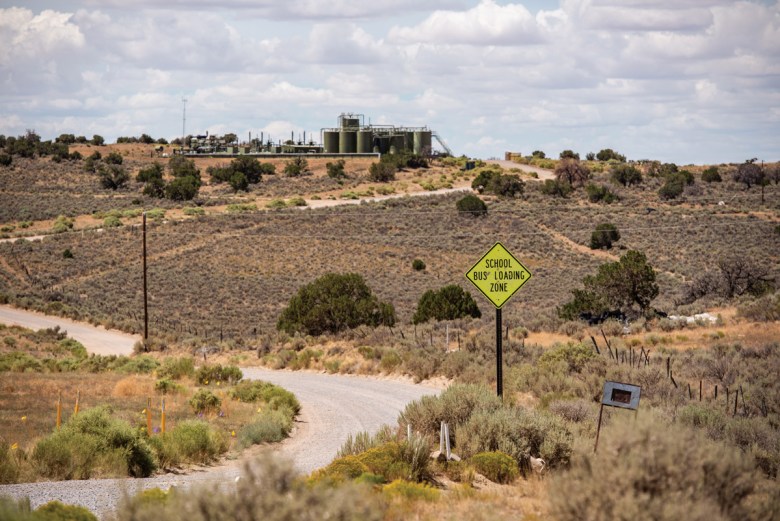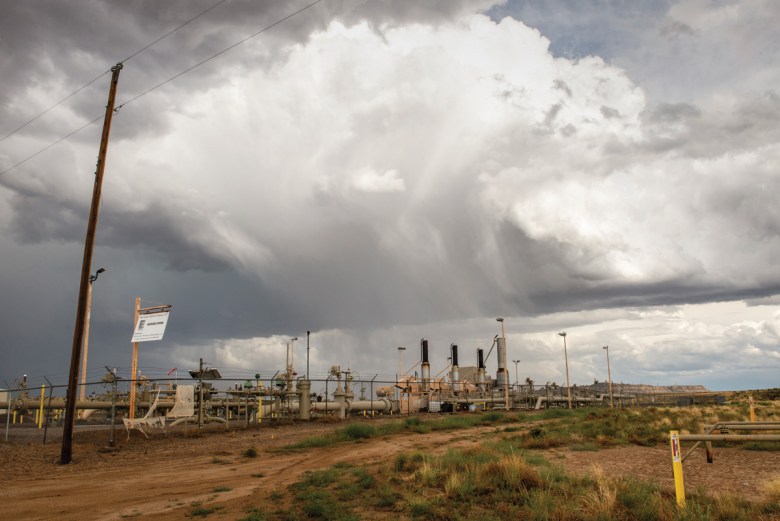It was late February, and intermittent snow blew across the road. On the gray, high-desert horizon, a dark structure loomed above the piñon and juniper. “This is a new one!” Kendra Pinto said, pointing at the well site
Pinto (Diné) grew up in this area, where sandstone mesas give way to shallow valleys and pale badlands of eggshell-colored clays. She watched the landscape change with the influx of fracking activity that peaked around 2014. Now, nearly a decade later, she is among the community’s most prominent critics of the industry. In 2017, she began volunteering for Earthworks, an environmental nonprofit focused on oil, gas and mining pollution. Now, she works for it as a thermographer, documenting air emissions using a specialized infrared camera designed to detect gas emission.
Driving to another site in Counselor Chapter, a small community in the eastern reaches of the Navajo Nation where the political chapters are outside the reservation boundaries, she described the different types of equipment — flare stacks, storage tanks, gas compressors — from which she commonly sees emissions. Pinto said that most air emissions seem to come from operators intentionally flaring or venting excess gases that build up in the equipment, rather than unintentional emissions, such as from aging underground pipes. She and her colleagues refrain from calling any emissions “leaks,” though: While these systems were designed to emit gas, usually as a safety mechanism, the vapor trails she films are often caused by malfunctioning equipment.
“If people were to be exposed to this air, they were also at risk of other non-cancer health outcomes, including respiratory, neurological and developmental effects.”
“These little flares should be lit and combusting all the hydrocarbons, but when you put the camera on (a lit flare), a portion of those hydrocarbons are still venting out into the atmosphere and along this horizon,” she said. “And that’s worrisome, because the air has no boundaries.”
The snow had ceased when Pinto trained the boxy, camcorder-
like device on another well site. To the naked eye, the row of 20-foot-tall storage tanks did not appear to be emitting anything unnatural. Using the camera, though, she toggled between monochrome and technicolor image modes, revealing a plume of hydrocarbons rising from an unlit flare stack near the tanks.
Across the region, wells suck crude oil and natural gas from shale formations thousands of feet below the surface. Some of the gas escapes, despite regulations to limit “venting and flaring” by operators. (Flaring is supposed to burn off the escaping methane, converting it to carbon dioxide, a less potent greenhouse gas.) At every juncture — from the wells extracting the hydrocarbons to the storage tanks, compressors and pipelines that convey the material — the system is rife with holes.

Hydrogen sulfide, a byproduct of oil and gas wells that smells like rotten eggs, is a frequent odor in oilfields. Even at very low concentrations, the toxic gas can sting the nostrils and cause nausea, dizziness, bloody nose and other acute symptoms. Inhaling extremely high concentrations of hydrogen sulfide in an enclosed space can kill a human almost immediately. The hydrocarbon soup that comes up from the shale also contains volatile organic compounds (VOCs), such as benzene, which has been shown to increase the risk of blood cancers and pregnancy complications.
A Harvard-led study of millions of people ages 65 and older showed that those living near fracking operations had a higher early mortality risk.
“If people were to be exposed to this air, they were also at risk of other non-cancer health outcomes, including respiratory, neurological and developmental effects,” said Lisa McKenzie, an associate professor with the Colorado School of Public Health who has studied the health impacts of oil and gas production.
The off-gassing benzene is one of the many air toxics that can escape from oil and gas infrastructure. Along with other VOCs like xylene and formaldehyde, the emissions contribute to air pollution in the form of ozone, nitrogen oxides and fine particulate matter. A 2022 study in Pennsylvania showed that children born within two kilometers (about 1.25 miles) of a fracking site were two to three times more likely to develop leukemia. In Colorado, McKenzie led studies showing that children with the blood cancer, as well as congenital heart defects, are more likely to live near oil and gas sites. Older people are also at risk: A Harvard-led study of millions of people ages 65 and older showed that those living near fracking operations — particularly downwind — had a higher early mortality risk compared to elderly people living in areas without wells.
In the mesa-lined valleys that surround Counselor, some wells pump petroleum within a few hundred feet of homes and traditional hogans; one well site lies less than 2,000 feet from a local school. The rural community’s exposure to VOCs and other air toxics has led to mounting concern among some residents about the potential health problems caused by the emissions.

PINTO, who captures footage at oil and gas sites in the area regularly, said she often has a headache “by mid-afternoon” in the field, and has also experienced eye and respiratory irritation that she attributes to exposure.
Given the enormous scale of the extraction activities and resulting air pollution in the Permian Basin — which straddles the New Mexico–Texas border — Pinto said the air-quality problems in her community are often overshadowed. “The problem for folks in this area is that the Permian will get a lot more attention than the San Juan Basin,” she said, noting that cleaning up the industry in the Four Corners region would likely prove more beneficial to human health. An Earthworks analysis shows that in the San Juan Basin, nearly 80% of the population lives within a half-mile of active oil and gas operations.
Another area drawing more media coverage and political attention lies closer to Counselor Chapter: In recent years, the U.S. Department of the Interior’s plan to halt federal oil and gas leasing near Chaco Culture National Historical Park has led to division among the area’s predominantly Navajo communities. The 10-mile buffer zone, which went into effect in June, encompasses all public lands surrounding the thousand-year-old Pueblo complex. The action drew the ire of pro-fracking residents, and was eventually opposed by the Navajo Nation Council and President Buu Nygren.
Many of those who opposed the leasing stoppage are from families who benefit from wells drilled on “Indian allotments,” tracts that the federal government allocated to Navajo households, who could then lease their mineral rights to oil and gas companies and receive royalty payments that are split between the original allottees’ heirs. Under the signed order, Navajo allottees are not prohibited from leasing their mineral rights, but many argue that the buffer zone will make their land less desirable for development. Delora Hesuse, an outspoken allottee from Nageezi Chapter, said that Navajo communities should be free to benefit from the area’s mineral resources, despite the potential exposure to pollutants.
“We do our homework,” Hesuse said. “Those issues have already been spoken about within the families.”
Pinto said she doesn’t relish filming in communities that tend to support oil-and-gas extraction. People have lashed out publicly against her and others who voice concern about the industry’s impact on the environment and community members. Disputes over mineral interests have, in some cases, led to physical violence.
“We absolutely know that malfunctions are not reported, that excess emissions are not reported and that there is noncompliance with regulations on a systematic, widespread basis.”
After documenting the malfunctioning flare, she logged details about the well, which is operated by Enduring Resources. Some of the footage she’s collected for Earthworks has been packaged as part of complaints the organization has filed with the New Mexico Environment Department.
A MAP OF the area reveals a complicated patchwork of land ownership, including federal, state, private and trust lands. Of the more than 21,000 active wells in the San Juan Basin, the majority were leased and permitted on public lands by the Bureau of Land Management. Oil and gas operators in the state are regulated by the New Mexico Oil Conservation Division (NMOCD), which, under the state’s 2021 Methane Waste Rule, is tasked with limiting the amount of natural gas that is wasted by the industry. In theory, that rule prohibits most routine venting and flaring. However, the law includes nearly a dozen exceptions that allow venting and flaring during “an emergency or malfunction,” as well as during scheduled maintenance or the “normal operation of a storage tank.”
Companies self-report their estimated emissions to the division, and are compelled to report any major flaring incidents, as in August of 2022, when more than 107 million cubic feet of gas were flared from a cluster of wells operated by DJR Energy near the community of Nageezi. And while substantial emissions are reported by companies, industry critics say those volumes are likely dwarfed by unreported and so-called fugitive emissions.

NMOCD director Dylan Fuge said equipment such as storage tanks may release gas “as a safety measure so the tanks don’t explode,” or for various other reasons during extraction, storage and transportation. Last year, operators in the northern part of the state reported venting of more than 197 million cubic feet. Fuge emphasized that operators are allowed to vent and flare under exceptions in state regulations, though he acknowledged the likelihood that “there are some” unreported emissions on the division’s watch.
Based on aerial footage, Liz Kuehn, Air Quality Bureau chief with the state Environment Department, is confident that unreported emissions are occurring in the basin. “We absolutely know that malfunctions are not reported, that excess emissions are not reported and that there is noncompliance with regulations on a systematic, widespread basis,” Kuehn told High Country News.
A new rule to limit the emission of “ozone precursors” from specific equipment should help curb VOC releases in the coming years, Kuehn added. Under the Oil Conservation Division’s new Methane Waste Rule, operators will be required to capture 98% of the methane they release by 2026. But environmental organizations say the agencies are letting the industry run roughshod over regulations intended to curb emissions. Earthworks has submitted more than 100 complaint videos to state Environment Department in the past five years, many of which were rejected based on technicalities, Pinto said.
To address some of the organization’s complaints, the agency adopted a system of notifying operators and the public about alleged violations, Kuehn said. The department has undertaken at least four major enforcement actions against operators in the basin over the past five years, while NMOCD has assessed no penalties against operators for venting and flaring in the basin since 2020. The NMOCD currently employs five inspectors in the basin, and the Environment Department has five inspectors statewide.
“It is frustrating that as much as (the agencies) bemoan a lack of resources, a lack of staffing, and an inability to enforce all the time everywhere, that they’re not taking small actions that could make things better in the meantime,” said Jeremy Nichols, who until August was the climate and energy program director for WildEarth Guardians. “The industry needs to be given the message that this behavior, these releases, they won’t be tolerated anymore.”
“You can already smell it when you approach that stop; it gets stronger and stronger until we get right by the tank. It could just give you a headache right there.”
The Navajo Nation EPA currently monitors air quality at two sites in New Mexico and Arizona, neither in the Counselor area, environment program supervisor Glenna Lee said, adding that the agency’s air-monitoring capacity is constrained by the limited grant funding it receives from the U.S. EPA. After requests for an interview, an agency spokesperson said in a statement, “EPA will continue to investigate matters that concern air quality in at-risk communities and we will work with our state partners to ensure public health concerns are addressed adequately.”
In recent years, the BLM has paused leasing throughout its Farmington Field Office area. A draft management plan for the region proposed in 2020 could allow for new drilling in the area. As of this year, that plan is still pending further review. Field manager Maureen Joe declined to address whether additional acreage may be opened in the future.
ON AUTUMN MORNINGS, school buses bounce along the rutted roads linking the rural communities, while children gather at makeshift bus stops in the morning chill. In 2022, a well near one of the stops gave off noxious odors that students had to endure for months, said Harry Domingo, who has driven routes in the area’s predominantly Diné communities for many years.
“You can already smell it when you approach that stop; it gets stronger and stronger until we get right by the tank,” he said. “It could just give you a headache right there.” On other stretches of road, the odors coming from oil-and-gas infrastructure cause students riding the bus to hold their nose and say “Eww,” he recalled.
Domingo is also the vice president of Counselor Chapter. In the past, he has shuttled K-8 students to Lybrook School, a sandstone-colored building overlooking Highway 550. The school used to be located several miles up the road, but was relocated after residents voiced health and safety concerns over a gas-processing plant across the street. In 2005, the school was reconstructed at its present location. A decade later, a drilling rig appeared across the street.

Five wells, now operated by Enduring Resources, were completed in 2015, at the tail end of a fracking boom in which hundreds of oil and gas wells were drilled in the region. The company reported venting at least 48,000 cubic feet of uncombusted gases across from the school in August 2022.
Near a shallow pass in the sandstone ridgeline, a few miles from Lybrook School, Marlene Thomas was cooking at home in the late afternoon. Outside her house, several dogs left tracks in the shallow snow that borders the driveway, which passes within 100 yards of an active well. For three decades, she worked as a community health representative for the Navajo Nation, a role that involved visiting homes throughout the area and consulting residents about their health. Now retired, Thomas said she suspects that the rash of oil and gas activity in the area has caused health problems in the community.
She was on a committee that conducted a community-driven Health Impact Assessment. Starting in 2016, the committee began speaking with residents who described experiencing sore throats, sinus problems, headaches and other symptoms often attributed to increased air pollution. In 2018, the committee conducted air monitoring that showed elevated levels of particulate matter and formaldehyde, and the presence of other VOCs.
Since Thomas retired, she’s continued to hear from community members about the perceived effects of the ongoing air quality issues. She spoke with one woman who said she’d noticed an increase in stillbirths in recent years. Talking about an elder who has since died from a “respiratory illness,” Thomas said the woman noted that her coughing and throat irritation worsened when she would herd her sheep near a particular well site. “She noticed a difference between when she was near” the facility and when she took her sheep in a different direction, which the woman said made her “feel a lot better,” Thomas recounted.

Sitting in his office a few miles away, former Chapter President Samuel Sage said he often smells the gas that collects in certain valleys. Sage, who has provided written testimony to Congress on the issue, said officials with the BLM and the Bureau of Indian Affairs never discussed the dangers posed by fracking during oil-leasing negotiations with allotment owners. “The first thing that was mentioned was, ‘If you sign this, you will get this much money,’ and of course, there was no hesitation,” he said.
While oil tankers tear up the dirt roads that branch off the highway, Sage said the industry’s presence has frayed the fabric of the community, pitting locals who support oil and gas development against those who are opposed to the industry encroaching on the landscape. Undeterred by the controversy, Pinto plans to continue putting pressure on regulators and the industry by documenting emissions and raising awareness of their potential health impacts.
“It’s not good for us, it’s not good for wildlife, it’s not good for plants,” Pinto said. “Are people getting paid enough to bear all these negative impacts — is it worth it?”
This reporting was supported by the Uproot Project.
Mark Armao (Diné) hails from the high desert in northern Arizona. Now based in California, his recent reporting has focused on environmental issues facing Indigenous communities.
This article appeared in the print edition of the magazine with the headline The long tail of toxic emissions.


